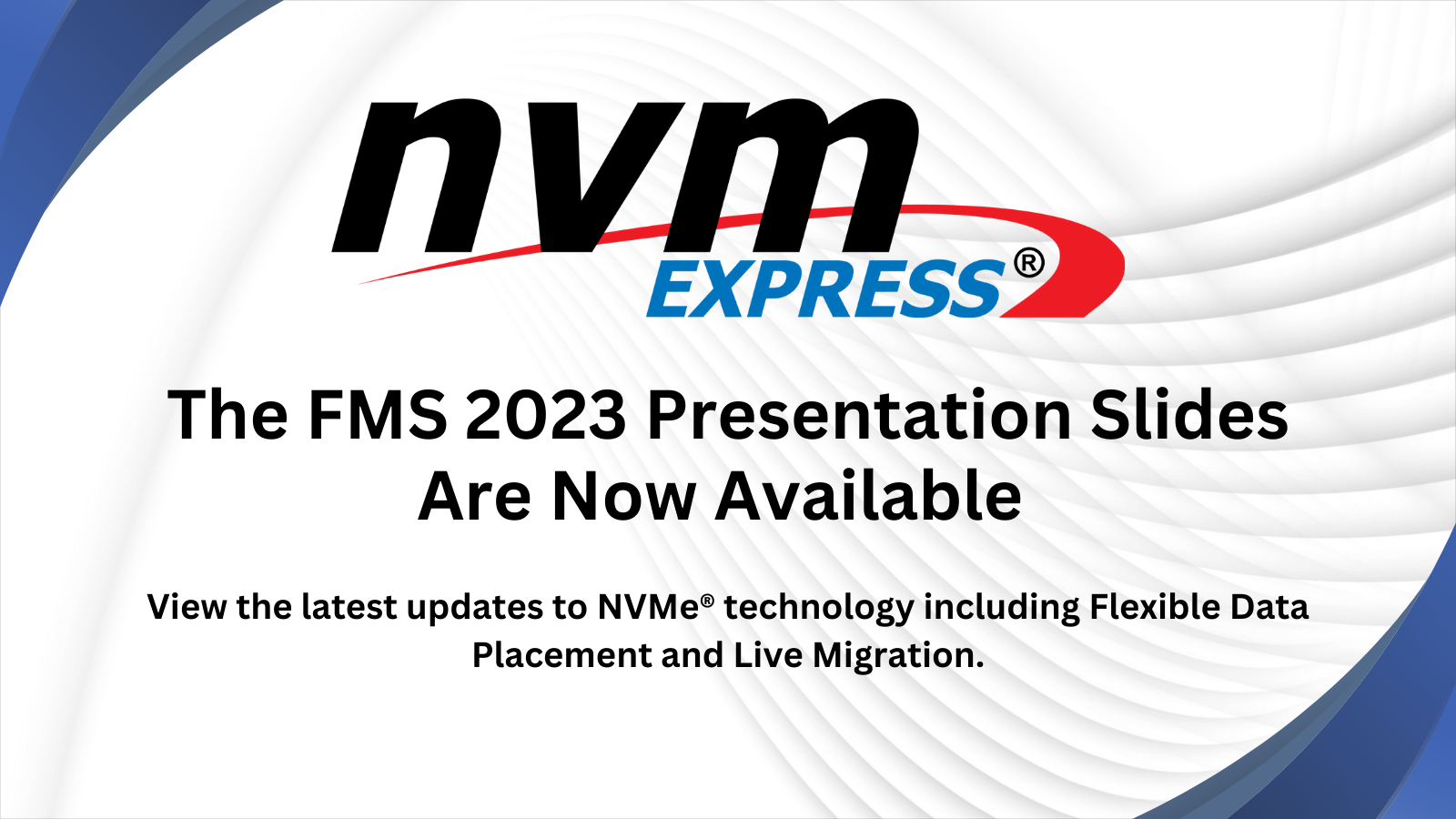
- This event has passed.
Flash Memory Summit (FMS) 2023 – NVM Express Presentation Track

NVM Express is proud to have been an organizational sponsor for Flash Memory Summit 2023, hosting a full speaker track dedicated to providing updates on the NVMe® technology ecosystem.
NVM Express State of the Union: The Language of Storage
NVM Express® (NVMe®) technology has become synonymous with high-performance storage seeing widespread adoption in client, cloud, and enterprise applications. Since the release of the NVMe 2.0 family of specifications, the NVM Express organization has released a number of new features to allow for faster and simpler development of NVMe solutions in order to support increasingly diverse environments. This presentation provides an overview of the latest NVMe technologies, summarizes the NVMe technology roadmap, and describes new NVMe standardization initiatives.
What's New in NVMe Technology: Ratified Technical Proposals to Enable the Future of Storage
In this presentation, attendees will get an overview of several of the new technical proposals (TP) ratified after FMS 2022 and not contained in the NVMe® 2.0 specifications. Included in the presentation is the new NVM Express® Boot Specification, copying user data between namespaces, virtualization of NVMe over Fabrics (NVMe-oF™) NVM subsystems, measuring and reporting Rx Phy eye opening, Flexible Data Placement, and more. Join us to find out how these new features will aid NVMe technology development and propel us into the future of storage.
Timberland Update: Booting over an NVMe/TCP Transport Using a UEFI Implementation
As large deployments become more common, our industry needs a standardized, multi-vendor solution to boot computer systems from OS images stored on NVMe® devices across a network. The newly published NVM Express® Boot Specification and ecosystem partnership with UEFI and ACPI enables this by leveraging the NVMe over Fabrics (NVMe-oF™) standard. This talk is a dive into the details of the new specification and the design of an open-source prototype for booting over an NVMe/TCP transport using a UEFI implementation.
Host Controlled Live Migration
To minimize any downtime in virtualized and cloud environments, a seamless migration of the Virtual Machine (VM) and associated resources needs to be completed without affecting the user experience in the case of any system failures or system maintenance. When a VM is migrated from one node to another node, the namespaces that the VM has access to also need to be seamlessly migrated. This presentation is an overview of capabilities being investigated by NVM Express to support a host controlling the migration of a VM and the namespaces used by that VM to a different controller where that controller may exist in a different NVM subsystem. This includes:
- Showing how the migration of the controller and namespaces are transparent to the VM being migrated.
- Identifying how a controller logs all live changes to the namespaces as the host migrates the allocated logical blocks of those namespaces.
- The ability to migrate the controller Head/Tail information on all queues after quiescing the controller operations.
- Restoring operations on the migrated controller such that commands not fetched prior to the migration are processed after the migration.
Computational Storage & Subsystem Local Memory
Learn what is happening in NVM Express to support Computational Storage devices. Computational Storage requires two new command sets: The Computational Programs Command Set and the Subsystem Local Memory Command Set. We will introduce you to how these two command sets work together, the details of each command set, and how they fit within the NVMe® I/O Command Set architecture. We will then discuss use cases that show how system performance and efficiency can be improved through the use of NVM Express® Computational Storage.
Flexible Data Placement (FDP) Overview
Please join Mike Allison, the lead author of the technical proposal, as he provides an overview of the ratified NVM Express® (NVMe®) TP4146 FDP and shows how to capitalize on lower WAF, extended endurance, and improved write performance of SSDs. This presentation covers:
- How to configure and enable FDP.
- How to manage FDP resources across multiple namespaces.
- The behavior of writing to the drive by software that does and does not utilize FDP.
- The differences between FDP, zoned namespaces, and streams.
How to use an Encryption Key per IO
The Key Per IO (KPIO) project was a joint initiative between NVM Express and the Trusted Computing Group (TCG) Storage Work Group to define a new KPIO Security Subsystem Class (SSC) under TCG Opal SSC for the NVM Express® (NVMe®) class of storage devices. Self-Encrypting Drives (SED) perform continuous encryption on user-accessible data based on contiguous LBA ranges per namespace. This is done at interface speeds using a small number of keys generated/held in persistent media by the storage device. KPIO allows a large number of encryption keys to be managed and securely downloaded into the NVM subsystem. Encryption of user data then occurs on a per command basis (each command may request to use a different key). These specifications are now available. This presentation will examine how to use this new capability to support use cases such as Support of EU – GDPR Support of data erasure when data is spread over many disks, support of data erasure of data that is mixed with other data needing to be preserved (multitenancy), assigning an encryption key to a single sensitive file or host object.